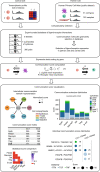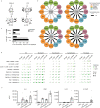Dissection of intercellular communication using the transcriptome-based framework ICELLNET
- PMID: 33597528
- PMCID: PMC7889941
- DOI: 10.1038/s41467-021-21244-x
Dissection of intercellular communication using the transcriptome-based framework ICELLNET
Abstract
Cell-to-cell communication can be inferred from ligand-receptor expression in cell transcriptomic datasets. However, important challenges remain: global integration of cell-to-cell communication; biological interpretation; and application to individual cell population transcriptomic profiles. We develop ICELLNET, a transcriptomic-based framework integrating: 1) an original expert-curated database of ligand-receptor interactions accounting for multiple subunits expression; 2) quantification of communication scores; 3) the possibility to connect a cell population of interest with 31 reference human cell types; and 4) three visualization modes to facilitate biological interpretation. We apply ICELLNET to three datasets generated through RNA-seq, single-cell RNA-seq, and microarray. ICELLNET reveals autocrine IL-10 control of human dendritic cell communication with up to 12 cell types. Four of them (T cells, keratinocytes, neutrophils, pDC) are further tested and experimentally validated. In summary, ICELLNET is a global, versatile, biologically validated, and easy-to-use framework to dissect cell communication from individual or multiple cell-based transcriptomic profiles.
Conflict of interest statement
Irit Carmi-Levy is a full-time employee at Aummune. Maximilien Grandclaudon is currently employed by the pharmaceutical company Servier. The remaining authors declare no competing interests.
Figures







References
-
- O’Shea, J., Gadina, M. & Siegel, R. M. in Clinical Immunology, Principles and Practice 5th edn (eds Rich, R. R., Fleisher, T. A., Shearer, W. T., Schroeder, H. W. Jr., Frew, A. J. and Weyand, C. M.) Ch. 9 (Elsevier, 2019).
-
- Wang, Y. et al. iTALK: an R Package to characterize and illustrate intercellular communication. 10.1101/507871 (2019).
Publication types
MeSH terms
LinkOut - more resources
Full Text Sources
Other Literature Sources
Molecular Biology Databases

